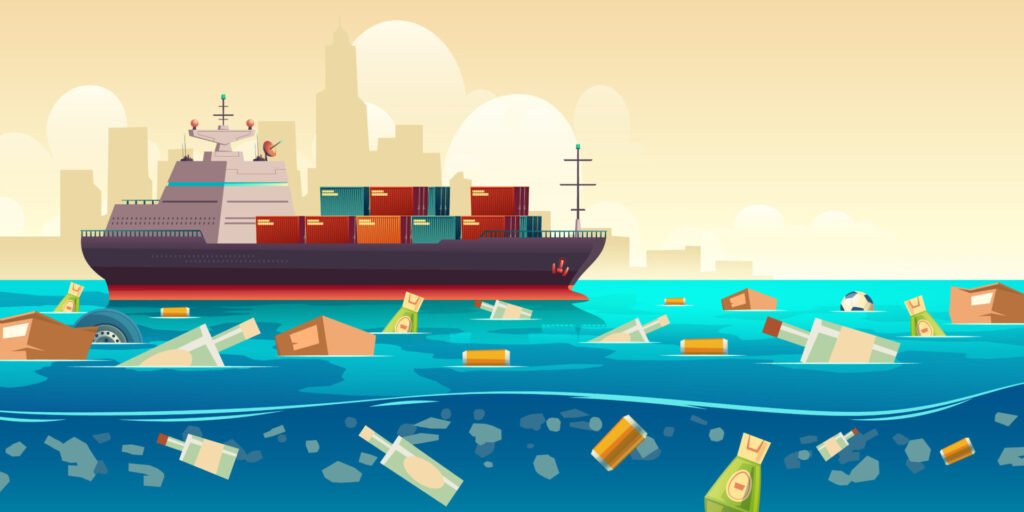Have you ever wondered where all the waste and trash from massive industrial operations ends up? Factories have to dump their byproducts somewhere, and the ocean has long seemed like an easy solution. Out of sight, out of mind, right? But the dirty secret is that marine dumping has become an environmental catastrophe. Raw sewage, toxic chemicals, plastic, and all manner of waste are routinely dumped into our oceans by companies looking to cut costs and maximize profits. And they don’t want you to know about it.
In this article, we’re going to dive deep into the murky waters of marine dumping. You’ll learn about the types of waste being dumped, which industries are the biggest offenders, the devastating impact on ocean life and ecosystems, and what can be done about it. The truth may shock you. Our oceans are not infinite dumping grounds, though many treat them that way. It’s time to expose this environmental crisis, and put an end to the careless destruction of our seas.

What Is Marine Dumping and Why Is It Harmful?
Marine dumping refers to the deliberate disposal of waste materials into oceans, rivers, and lakes. While it may seem convenient for industries and governments to dump waste into large bodies of water, this practice is extremely harmful to the environment.
Why is it bad?
There are several reasons why marine dumping devastates aquatic ecosystems:
- It pollutes the water with toxic chemicals, heavy metals like mercury and lead, plastic debris, and other hazardous materials that poison marine life and enter the food chain. Many of these pollutants accumulate in the tissues of fish and other animals, threatening human health when consumed.
- It destroys habitats and kills massive amounts of fish, birds, and other wildlife. Dumping waste like plastic, mining tailings, dredged sediment, and sewage sludge smothers the sea floor, suffocates coral reefs, and entangles or poisons animals.
- It disrupts the natural cycles of nutrients and sediments in bodies of water. Dumping large volumes of waste in one area can overload the system and throw it out of balance. This makes it difficult for plants and animals to survive.
- It compromises economies that depend on marine resources. Pollution and loss of marine life from dumping undermine industries like tourism, fishing, and recreation. It also ruins natural beauty and public enjoyment of aquatic environments.
- It has unknown long-term consequences that threaten future generations. While some impacts of dumping are immediate, many pollutants and their interactions with ecosystems are still not fully understood. The devastating effects may last for decades or centuries.
In summary, marine dumping is an irresponsible practice that destroys the environment, damages human health, and compromises livelihoods and economies. Preventing further damage requires transitioning to sustainable waste management and conservation of water resources. The future of our oceans and waterways depends on it.
A Brief History of Marine Dumping Regulations
When industries first started dumping waste into oceans, lakes and rivers, there were no regulations or oversight. Companies were free to dump whatever they wanted, wherever they wanted. As pollution rose to catastrophic levels, governments started taking action to curb the damage.
The First Wave of Regulations
In the 1970s, many countries ratified the London Dumping Convention, banning the dumping of industrial waste and sewage sludge in the ocean. The U.S. passed the Marine Protection, Research, and Sanctuaries Act, restricting dumping within 200 miles of the coastline.
While these were good first steps, loopholes remained. Many toxic chemicals were still allowed, and enforcement was difficult. Public outcry led to stricter laws in the 1980s, like the Ocean Dumping Ban Act, banning the dumping of sewage sludge and industrial waste in U.S. waters. The Act for the Prevention of Pollution from Ships (MARPOL) also set rules for ships to properly dispose of waste and not pollute the seas.
The Modern Era of Regulation
Today, most forms of ocean dumping are banned or strictly limited by international treaties and domestic laws. However, some industries have found ways around the rules. Cruise ships, for example, still dump large amounts of sewage, food waste, and chemicals. Plastic pollution from single-use plastics has also become an enormous problem.
More recently, the international community came together to regulate plastic waste and microplastics. The MARPOL treaty now bans ships from throwing plastics overboard, and the Basel Convention restricts the export of plastic waste from developed to developing nations. However, plastics pollution remains an ongoing problem, and more action is still needed.
While we’ve come a long way, constant vigilance and improvement in policy and enforcement are required. Our oceans remain under threat, but by working together, we can find solutions so that one day we have seas free of pollution. Our planet depends on it.
The Most Common Materials Dumped at Sea
The oceans have long been used as dumping grounds for hazardous waste and trash that industries and nations want to get rid of, but don’t want you to know about. Some of the most common materials dumped in our seas include:
Plastics
- Plastic pollution in the oceans has become an environmental crisis. Everything from plastic bags, bottles, and food containers to microplastics end up in the water, polluting shores and harming marine life. The biggest sources of plastics are land-based, from litter and waste that flows into rivers and streams before making its way into the seas. But some plastics also come from marine dumping, especially abandoned fishing gear called “ghost gear” that continues to trap and kill fish and other animals.
- Reducing single-use plastics and improving recycling and waste management are critical to solving this urgent problem. We all must do our part to minimize plastic use and properly dispose of plastics to keep them out of the environment.
Chemicals and industrial waste
- Hazardous chemicals, heavy metals like mercury and lead, pesticides, fertilizers, and industrial byproducts are frequently dumped into oceans under the cover of night. These pollutants poison marine ecosystems and the creatures that inhabit them, including dolphins, whales, fish, seabirds, and coral reefs. They also pose threats to human health as they enter the food chain and water supply.
- Developed nations often ship toxic waste to poorer countries with loose regulations, who then dump the waste in international waters to avoid liability. This unethical practice must end through global policy changes and environmental protections. We share one planet, so we must work together to safeguard the oceans we all depend upon.
Sewage and wastewater
- Untreated sewage, wastewater, and runoff from farms and cities are major problems for our seas. They introduce high levels of nutrients, chemicals, pharmaceuticals, and microplastics that create ocean “dead zones,” harm wildlife, and sicken communities. Proper treatment and management of wastewater and sewage are urgently needed, especially in developing parts of the world with limited infrastructure.
Reducing pollution at its source is the only way to truly solve these grave issues. We must find ways to minimize waste, limit hazardous chemicals, decrease single-use plastics, and improve recycling worldwide. Our oceans sustain all life on Earth, so protecting them is really about ensuring our shared future. Together, we can make a difference by transitioning to more sustainable practices and pressuring companies and governments to do the right thing. Our planet depends on it.
Which Industries Are the Biggest Marine Dumpers?
The marine dumping of industrial waste is an enormous problem that threatens our oceans and the life within them. Several major industries are responsible for the bulk of what gets dumped, often illegally, into our seas each year.
Oil and Gas
- The oil and gas industry generates massive amounts of toxic waste as a byproduct of drilling and refining oil. Rather than properly dispose of these hazardous chemicals and waste on land, much of it ends up getting dumped directly into the ocean to cut costs. According to reports, the oil and gas industry dumps over 10 million barrels of waste into oceans each year, including known carcinogens like benzene. The long term effects of these dumps are still largely unknown.
Mining
- Mining companies also frequently dump their waste into oceans, rivers and lakes. Called acid mine drainage, the waste from mining operations is often highly acidic and contains dangerous heavy metals like mercury, lead and arsenic. This waste devastates aquatic life and the environment. Some of the worst offenders are gold, coal and metal mining companies. They’ve been getting away with these unregulated dumps for decades due to lack of enforcement and oversight.
Agriculture
- Agricultural runoff from farms, especially large industrial farms, flows into waterways and eventually oceans, carrying with it dangerous amounts of chemicals, animal waste, and sediment. Common pollutants from agriculture include fertilizers, pesticides, hormones, antibiotics and pathogens. This runoff creates massive dead zones in the ocean, algal blooms and the destruction of coral reefs. Despite this damage, the agricultural industry remains largely unregulated when it comes to waste and byproduct management.
Shipping
- The large cargo ships that transport most of the world’s goods have long been dumping waste, sewage, oil, and trash directly into the ocean. An estimated 10 billion pounds of this waste enters our oceans each year from ships. Governments have banned the dumping of plastics and regulated other wastes, but enforcement remains difficult given the remote areas many ships travel. The damage from years of dumping is still being uncovered, with plastics and pollutants accumulating in marine life and washing up on shores around the world.
The marine dumping of waste by these massive industries is an environmental crisis that threatens our oceans, the climate and human health. Stricter regulations and enforcement are urgently needed to put an end to these irresponsible and illegal dumping practices before it’s too late. Our oceans sustain all life on the planet, so making their health a priority benefits us all.
The Environmental and Health Impacts of Marine Dumping
The marine dumping of industrial waste and trash poses real threats to the environment and human health. What’s being dumped may surprise you. Let’s take a closer look at what’s really going on and how it impacts our oceans, marine life, and even our own health.
Raw sewage and wastewater
- Many coastal cities still dump raw sewage and wastewater directly into the ocean. This introduces disease-causing pathogens like bacteria, viruses and parasites into the marine environment. As marine animals ingest this contaminated water, these pathogens enter the food chain and accumulate in seafood that humans consume, which can lead to health issues like hepatitis, gastroenteritis, and other illnesses.
Heavy metals and toxic chemicals
- Industrial waste, mining tailings, and electronic waste frequently contain heavy metals such as lead, mercury and cadmium, as well as toxic chemicals like PCBs and dioxins. When released into the ocean, these pollutants are absorbed by marine animals and plants, accumulating in their tissues and making their way up the food chain to humans. Exposure to these toxins can cause cancer, damage organs, and impair the nervous system.
Plastic pollution
- An enormous amount of plastic waste ends up in the ocean each year, damaging ecosystems and entangling or being ingested by marine animals. Plastic also releases toxic chemicals as it breaks down into microplastics, which have been found in seafood and table salt. The long term impacts of microplastic consumption on human health are still unknown but likely pose risks.
Destruction of marine habitats
- Dumping dredged materials from harbors and channels smothers seafloor habitats like coral reefs, seagrass beds and kelp forests. These habitats provide shelter and nursery grounds for many marine species, so their destruction threatens biodiversity and fisheries. Sediment plumes from dredging and dumping also reduce light penetration in the water column, damaging plankton and other organisms at the base of the food web.
The ocean cannot continue to be used as a trash bin and sewer. Stronger regulations, reduction of waste and transitioning to more sustainable practices can help curb pollution from industrial dumping and protect the health of our seas. The future of our environment and food supply depends on the actions we take today. Together, we can make a difference by pressuring companies and governments to do the right thing and make a change.
Conclusion
You now have the inside scoop on what’s really going on in our oceans. The truth is, mega-corporations are treating them like a giant trash can to avoid paying for proper waste disposal. While these practices may cut costs in the short term, the long term effects on marine life and human health are catastrophic.
Don’t let industry lobbying groups convince lawmakers and the public that marine dumping is a victimless crime. Our oceans are not an infinite resource, and they’re certainly not a free dumping ground. You have the power to create change by making your voice heard and voting with your dollars. Support companies with strong environmental values and avoid those with a history of pollution.
Together, we can put an end to these harmful practices and protect our planet for future generations. The choice is yours—will you be part of the solution? Our oceans are depending on you.








